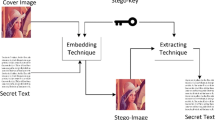Abstract
The crucial challenge that decides the success of any steganographic algorithm lies in simultaneously achieving the three contradicting objectives namely—higher payload capacity, with commendable perceptual quality and high statistical un-detectability. This work is motivated by the interest in developing such a steganographic scheme, which is aimed for establishing secure image covert channel in spatial domain using Octonary PVD scheme. The goals of this paper are to be realized through: (1) pairing a pixel with all of its neighbors in all the eight directions, to offer larger embedding capacity (2) the decision of the number of bits to be embedded in each pixel based on the nature of its region and not done universally same for all the pixels, to enhance the perceptual quality of the images (3) the re-adjustment phase, which sustains any modified pixel in the same level in the stego-image also, where the difference between a pixel and its neighbor in the cover image belongs to, for imparting the statistical un-detectability factor. An extensive experimental evaluation to compare the performance of the proposed system vs. other existing systems was conducted, on a database containing 3338 natural images, against two specific and four universal steganalyzers. The observations reported that the proposed scheme is a state-of-the-art model, offering high embedding capacity while concurrently sustaining the picture quality and defeating the statistical detection through steganalyzers.










Similar content being viewed by others
References
Avcibas N, Memon, Sankur B (2003) Steganalysis using image quality metrics. IEEE Trans Image Process 12(2):221–229
Bui C-N, Lee H-Y, Joo J-C, Lee H-K (2010) Steganalysis method defeating the modified pixel-value differencing steganography. Int J Innov Comput Inf Control 6(7):3193–3203
Chan C-K, Cheng LM (2004) Hiding data in images by simple LSB substitution. Pattern Recogn 37(3):469–474, 4
Chang K-C, Chang C-P, Huang PS, Tu T-M (2008) A novel image steganographic method using tri-way pixel-value differencing. J Multimedia 37(2):44, 6
Dumitrescu S, Wu X, Wang Z (2003) Detection of LSB steganography via sample pair analysis. IEEE Trans Signal Process 51(7):1995–2007
Farid H (2002) Detecting hidden messages using higher-order statistical models. Proc IEEE Int Conf Image Process 2:905–908
Fridrich J, Goljan M, Du R (2001) Detecting LSB steganography in color, and gray-scale images. IEEE Multimedia 8(4):22–28
Geetha S, Sivatha Sindhu SS, Kamaraj N (2010) Passive steganalysis based on higher order image statistics of curvelet transform. Int J Autom Comput 7(4):531–542
Goljan M, Fridrich J, Holotyak T (2006) New blind steganalysis and its implications. Proc SPIE Secur Forensic Steganography Watermark Multimed 6072:1–13, 12
Hempstalk K (2006) Hiding behind corners: using edges in images for better steganography. In: Proc. Computing Women’s Congress, Hamilton, New Zealand. 14
Hong W (2013) Adaptive image data hiding in edges using patched reference table and pair-wise embedding technique. Inf Sci 221(1):473–489, 51
Images were obtained from: http://philip.greenspun.com/. 16
Jung K-H, Ha K-J, Yoo K-Y (2008) Image data hiding method based on multi-pixel differencing and LSB substitution methods. In: Proc. 2008 International Conference on Convergence and Hybrid Information Technology (ICHIT ′08). Daejeon (Korea). pp 355–358
Ker AD (2005) Steganalysis of LSB matching in grayscale images. IEEE Signal Proc Lett 12(6):441–444
Lee YP, Lee JC, Chen WK, Chang KC, Su IJ, Chang CP (2012) High-payload image hiding with quality recovery using tri-way pixel-value differencing. Inf Sci 191(1):214–225, 53
Li X, Zeng T, Yang B (2008) Detecting LSB matching by applying calibration technique for difference image. In: Proc. 10th ACM Workshop on Multimedia and Security, Oxford, U.K., pp 133–138
Lie W-N, Lin G-S (2005) A feature-based classification technique for blind image steganalysis. IEEE Trans Multimed 7(6):1007–1020
Lin YK (2012) High capacity reversible data hiding scheme based upon discrete cosine transformation. J Syst Softw 85(10):2395–2404, 52
Luo W, Huang F, Huang J (2010) Edge adaptive image steganography based on LSB matching revisited. IEEE Trans Inf Forensic Secur 5(2):201–214
Mielikainen J (2006) LSB matching revisited. IEEE Signal Proc Lett 13(5):285–287
NRCS Photo Gallery Home, http://photogallery.nrcs.usda.gov/. 32
Sabeti V, Samavi S, Mahdavi M, Shirani S (2009) Steganalysis of embedding in difference of image pixel pairs by neural network. ICS Int J Inf Secur 1(1):17–26
Schaefer G, Stich M (2003) UCID: an uncompressed color image database. Proc SPIE Electron Imaging Storage Retr Methods Appl Multimed 5307:472–480, 35
Sharp T (2001) An implementation of key-based digital signal steganography. In: Proc. 4th Information Hiding Workshop. 2137 of Springer LNCS, pp 13–26. 36
Shi YQ et al. (2005) Image steganalysis based on moments of characteristic functions using wavelet decomposition, prediction-error image, and neural network. In: Proc. IEEE Int. Conf. Multimedia and Expo, pp 269–272
Wang CM, Wu NI, Tsai CS, Hwang MS (2008) A high quality steganography method with pixel-value differencing and modulus function. J Syst Softw 81:150–158, 39
Westfeld A, Pfitzmann A (1999) Attacks on steganographic systems. In: Proc. 3rd Int. Workshop on Information Hiding 1768:61–76. 40
Wu DC, Tsai WH (2003) A steganographic method for images by pixel-value differencing. Pattern Recognit Lett 24(9–10):1613–1626, 41
Yang CH, Weng CY (2006) A steganographic method for digital images by multi-pixel differencing. In: Proc. Int. Comput. Symp, Taipei, Taiwan, R.O.C. pp 831–836. 44
Yang CH, Weng CY, Wang SJ, Sun HM (2008) Adaptive data hiding in edge areas of images with spatial LSB domain systems. IEEE Trans Inf Forensic Secur 3(3):488–497, 45
Zhang X, Wang S (2004) Vulnerability of pixel-value differencing steganography to histogram analysis and modification for enhanced security. Pattern Recognit Lett 25:331–339, 46
Zhang W, Zhang X, Wang S (2007) A double layered “Plus-minus one” data embedding scheme. IEEE Signal Proc Lett Signal Proc Lett IEEE 14(11):848–851, 48
Acknowledgements
This paper is based upon work supported by the All India Council for Technical Education - Research Promotion Scheme under Grant No. 20/AICTE/RIFD/RPS(POLICY-II)65/2012-13.
Author information
Authors and Affiliations
Corresponding author
Rights and permissions
About this article
Cite this article
Balasubramanian, C., Selvakumar, S. & Geetha, S. High payload image steganography with reduced distortion using octonary pixel pairing scheme. Multimed Tools Appl 73, 2223–2245 (2014). https://doi.org/10.1007/s11042-013-1640-4
Published:
Issue Date:
DOI: https://doi.org/10.1007/s11042-013-1640-4




